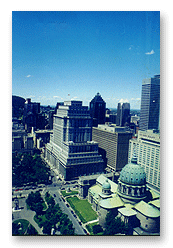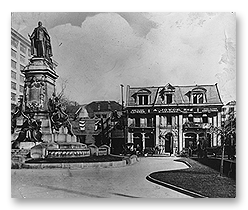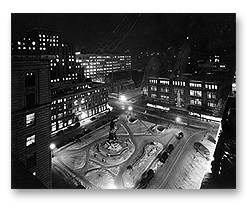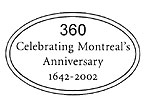
|
|
||||||||||
 |
Downtown Montreal - Phillips Square Excerpt from Downtown Montreal: An Opinionated Guide to the City's Squares, Churches, & Underground City by Alan Hustak
Every centre, large or small has its own version of Phillips Square, a place in the heart of its commercial district that distills the values of the community. Phillips Square was carved out of property that initially belonged to fur trader Joseph Frobisher, (1740-1810) one of the original found- ing partners of the Northwest Trading Company. It is named, however, for Thomas Phillips, a building contractor and city councillor who bought the land from Frobisher, and who died in 1842. The same year his widow, Martha Anderson, donated the parcel of property to be used as a perpetual memorial to her husband. At the time it was an open field, a cow pasture really, with a commanding view of the old city below. Anderson had hoped the field would be converted into a belvedere to link the emerging residential neighbourhood around the Anglican cathedral with the retail district around Victoria Square at the bottom of Beaver Hall Hill. The first merchant to open a business on Phillips Square was Alfred Joyce, “the high class caterer and confectioner” and one-time mayor of the town of Outremont who built an elegant shop on the south side of the square in 1878. The following year the Montreal Art Association moved into a building along the east side, but the square did not become a hub of the city’s uptown retail district until the 1890s.The square is dominated by a bronze statue of Britain’s King Edward VII, who ruled from 1901 to 1910. He visited Montreal in 1860, when he was still the Prince of Wales, to open the Victoria Bridge and was perhaps the last monarch to be regarded with genuine affection in Quebec. The statue by Louis-Philippe Hébert commemorates Edward the Peacemaker, and was unveiled in 1914. The four allegorical figures at the base of the monument represent Peace, Four Nations, Abundance, and Liberty. Armed Peace is the woman at the front holding the olive branch, but if you look carefully there is a sword hidden in the folds of her skirt, just in case—a reminder that force is sometimes necessary if you want to keep the peace. Four Nations, the group to the west, represent Montreal’s four founding nationalities—French, Scots, Irish, and English—living together in harmony. At the back of the monument is Winged Genius which represents liberty. The angel has broken the shackles of religious prejudice and persecution and is a reminder that during the king’s reign he extended respect and dignity to all his subjects around the world, regardless of race, colour, or creed.
The statue faces The Bay/La Baie (585 Ste-Catherine St. W.) which has been doing business in Canada for more than 300 years. The Hudson Bay Company began as a fur trading company in 1670 and over the centuries has developed into one of the world’s major corporations. The distinctive red sandstone building designed by John Pearce Hill opened in 1891 as Morgan’s, which at the time was Montreal’s largest independent retail outlet. The store was enlarged in 1923. The building’s foundations contains stone salvaged from Canada’s first Parliament buildings after they were burned by a mob in 1849 when Montreal was still the capital of Canada. Stones from the blackened ruins in Place d’Youville were carted away by John Honey who used them to built a row house that was demolished in the 1890s when Morgan’s was built. The stones were in such good condition, the building contractors made use of them. The Hudson’s Bay Company bought out Morgan’s in 1959 and took over the building. The site is of particular interest to visitors from the U.S. Confederate President Jefferson Davis sent his family to live in Montreal during the civil war. A brass marker installed on the west side of The Bay indicates the spot where Varina Davis and her four children lived during the war between the states. Originally the plaque, unveiled in 1958, was in English and French, but several years ago someone—probably a “damn yankee,” stole it. The replacement, erected by the Daughters of the Confederacy is in French only. It is dedicated to the memory of “Jefferson Davis, president of the Confederate States, who came in 1867 to stay in John Lovell’s house which then stood here.” The west side of Phillips square is bounded by Birks(1240 Phillips Square, 514-397-2511), for 115 years Canada’s answer to New York’s Tiffany’s. The jewelery store, part Romanesque, part Italian Renaissance, designed by Edward Maxwell and built of Miramichi sandstone, opened in 1894. The boardroom is a replica of the one in the Bank of England, and the coffered ceiling in Wedgewood blue is alone worth walking in to see. The store was enlarged twice, in 1906 and 1931, and the interior completely refurbished in 2001. Birks opened its first store in Old Montreal in 1879 and expanded throughout Canada. Although the store still displays its Royal Warrant from the Prince of Wales to the right of the main door, royalty doesn’t shop here anymore. The warrant expired in 1950. It was given to the store in 1934 by Edward VII’s grandson, who abdicated as king in 1936 and became the Duke of Windsor. The store’s trademark blue box with a rampant lion was introduced in 1944, and Birks has been considered a seriously upscale store ever since. The family-owned business went bankrupt in 1993 and was sold to an Italian Company, Iniziativa Regaluxe, which has kept the Birks trademark but lost some of the store’s original cachet. Its quirky, fanciful and sometimes surreal window displays put together by Lucy Ann Bouwman are always eye-catching and are recognized as among the best in North America.
On the South side of the square, where Alfred Joyce once had his pastry shop, is the Canada Cement Building, (606 Cathcart) built in 1921. Designed by Barott and Blackader, the dignified 10-storey building was the firstoffice tower to be built completely of reinforced concrete. Canada Cement was founded by Max Aitken, later Lord Beaverbrook, and Barott convinced him to use concrete in the building of his head office to advertise his cement-based products. The building was considered avant garde when it opened because it was the first skyscraper in Montreal to have an underground parking garage, at a time when there weren’t too many automobiles on the road. From 1922 to 1927, Montreal’s first English language radio station, CFCF had its broadcast studios in the building. The fast food outlet on the east side of Phillips Square (on the corner) is where Montreal’s first art gallery was opened by Princess Louise and the Marquis of Lorne in 1879. The first home for the Art Association of Montreal, and the first building in Canada “erected wholly for fine art purposes,” had one gallery with a skylight. Within 20 years it proved to be inadequate to house the Association’s growing collection. Rather than renovate the building on Phillips Square a new art museum, today known as the Montreal Museum of Fine Arts, was built on Sherbrooke Street and opened in 1912. The old gallery was converted into a pool room and in 1948 the building was torn down to make way for the nondescript building at 1255 Phillips Square that houses retail jewelers and gemologists. Dunn’s next door, (1219 Phillips Square) is one of Montreal’s oldest delis, but its Phillips square location is new. Dunn’s reputation as a deli was established when Russian immigrant Meyer Dunn first opened the deli in 1927 in the old Jewish neighbourhood around Mount Royal Avenue. In 1948 it moved to 892 Ste-Catherine St. West and its storefront window stacked with huge jars of dill pickles, banana peppers, and cheesecake became something of a local landmark. The restaurant closed in 1998, but the founder’s grandson revived it in 2000. A wall mural inside depicts the old smoked meat diner merging with the new location. You might also want to try Le Grande Comptoir two doors north (1225 Philillips Square, 514-393-3295) which serves bourgeois French fare—boudin, cassoulet, and cream sauces—at modest prices. They have an outdoor terrace that overlooks the square. © 2002, Alan Hustak |
|||||||||
|
| Downtown Montreal Guide | Old Montreal Guide | Guide to Eating Out |
| Walking Tours | Urban Landscape | Guide to Literary Montreal | | Montreal Vintage Photos | Montreal Links | Montreal Jazz | www.vehiculepress.com © Véhicule Press, All Rights Reserved |



